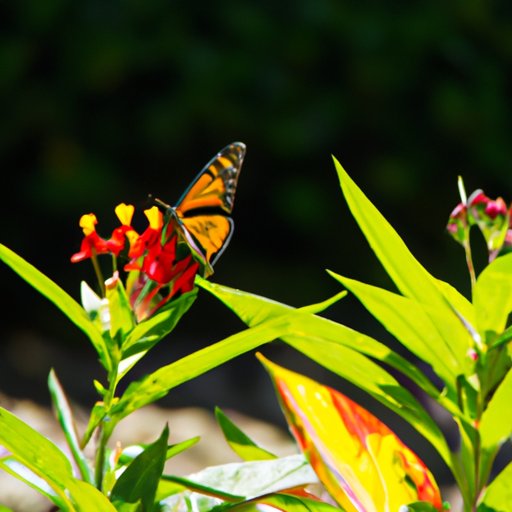Introduction
Are you looking to add some natural beauty to your yard while also attracting butterflies? Planting butterfly-attracting plants can help you do just that. Butterflies bring a sense of wonder and peace to any outdoor area while also assisting in pollination. In this article, we’ll be exploring the top plants to attract butterflies, the best locations to plant them, and how to create a butterfly garden in your own backyard.
Top 6 Butterfly-Attracting Plants
Butterflies are visual creatures and are drawn to vibrant, sweet-scented flowers. Here are six of the best butterfly-attracting plants:
Milkweed
Milkweed is the primary host plant for monarch butterflies, making it a must-have in any butterfly garden. Its tall, bright flowers add a pop of color and its nectar is also a favorite among many other butterflies.
Purple Coneflower
Purple coneflower is a beautiful and hearty plant that blooms throughout the summer, appealing to many butterfly species. Its pinkish-purple blooms are supplemented by its fragrant scent.
Zinnia
Zinnias are a vibrant option that come in a variety of colors. Their compact petals make it easy for butterflies to collect nectar. Zinnias bloom throughout the summer and are easy to grow from seed.
Butterfly Bush
The name says it all – butterfly bushes are a favorite among many butterfly species. Its bright, showy flowers bloom throughout the summer, providing a habitat for butterflies to feed and lay eggs.
Lantana
Lantanas are a low-maintenance option that bloom throughout the summer until the fall. They produce an abundance of nectar and attract many different species of butterflies with their brilliant blooms.
Black-Eyed Susan
Black-Eyed Susans are a hardy and reliable plant that blooms throughout the summer and into the fall. Its yellow petals and dark center are attractive to many butterfly species, making it a great choice for any butterfly garden.
Location-Based Plants
Depending on where you live in the United States, different plants may fare better in attracting butterflies. Here are some location-based plants that have proven successful:
Midwest
Wild Bergamot, Swamp Milkweed, and Wild Blue Indigo are native to the Midwest and are popular butterfly-attracting plants.
Northeast
New England Aster, Goldenrod, and Purple Loosestrife are just a few of the plants that do well in the Northeast region.
West Coast
California Buckwheat, Common Yarrow, and Coyote Mint are all top choices for butterfly-attracting plants on the West Coast.
Common and Lesser-Known Plants
Some plants that attract butterflies may not be as well known as others, but are still a great option for your butterfly garden:
Lamb’s Ear
Lamb’s Ear is a soft and fuzzy plant that blooms with pink flowers in the summer. It is loved by butterflies and bees alike.
Bee Balm
Bee Balm is a showy plant that blooms with brilliant flowers in shades of pink, red, and purple. It is also great for attracting hummingbirds.
Honeysuckle
Honeysuckle is a fragrant plant that is known for attracting hummingbirds and butterflies. Its sweet aroma is sure to draw in a variety of species.
Borage
Borage is an herb with beautiful blue flowers that bloom throughout the summer. It is popular among many butterfly species and can also be used in cooking.
How-To Create a Butterfly Garden
Creating a butterfly garden is easy and can be done with any size yard, from a small balcony to a larger backyard. Here are some steps to follow when designing your butterfly garden:
Choose a location
Select an area that gets full sun and has well-drained soil. Butterflies prefer open areas and are less likely to visit a garden that is shaded and cramped.
Select your plants
Choose a mix of host and nectar plants for your butterfly garden. Host plants provide food and habitat for butterfly larvae while nectar plants provide food for butterflies. Refer to the lists above for some ideas.
Provide shelter
Butterflies need shelter from wind and predators. Provide shelter by planting taller plants, adding a butterfly house, or leaving a space with rocks or logs in your garden.
Provide water
Butterflies need water, but prefer it in a shallow dish or birdbath with wet sand or a sponge instead of a deep pool to avoid drowning.
The Science of Planting
When it comes to planting for butterflies, there are certain scientific principles to follow. One of these is the importance of planting native species. Butterflies are adapted to their local environment and will be more attracted to flowers that are native to the area. Additionally, butterflies are attracted to bright colors, particularly red, yellow, and orange. Fragrance is also important in attracting butterflies, which is why many flowering plants have sweet, floral scents.
Finally, planting butterfly-attracting plants not only adds beauty to your yard, but also supports butterfly conservation efforts. Many butterfly populations have decreased in recent years due to habitat loss and pesticides. By planting butterfly-attracting plants, you can create a habitat that promotes butterfly survival and helps maintain a healthy ecosystem.
Conclusion
Planting butterfly-attracting plants is a simple way to add beauty to your yard while also conserving local butterfly populations. By following the steps outlined in this article, you can create a butterfly garden that will attract a variety of species throughout the year. Remember to choose a sunny location with well-drained soil, select a mix of host and nectar plants, provide shelter and water, and plant native species whenever possible.
